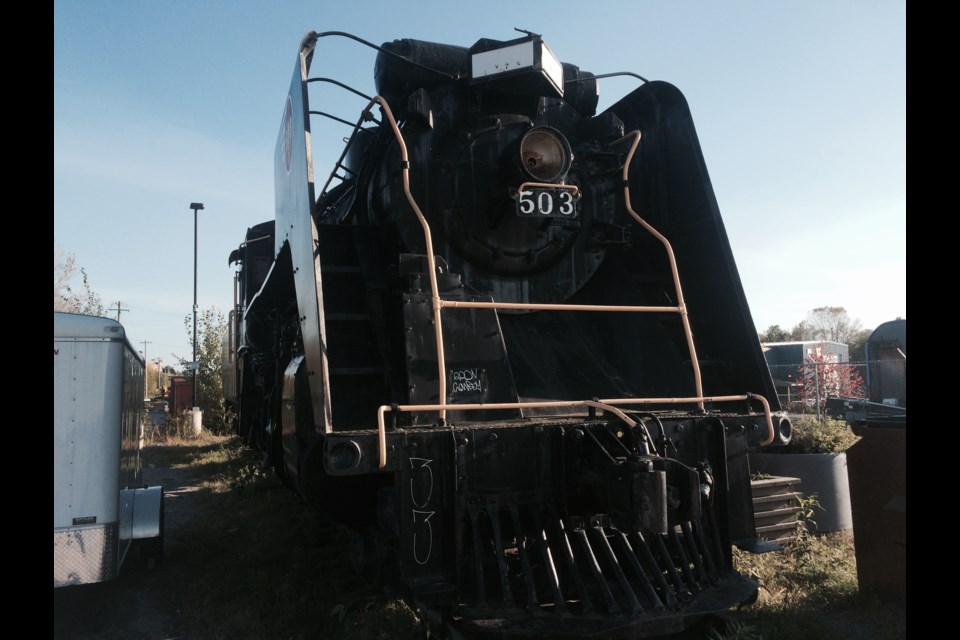The Temiskaming and Northern Ontario 503 steam locomotive was built in 1930, for the Ontario Northland Railway. It was retired from active service in the late 50's and was donated to the City of North Bay in 1960. The locomotive has sat idle ever since, first at North Bay's Lee Park and now at the waterfront park.
There is interest in bringing the locomotive back to life.
The curious attended a public meeting at Discovery North Bay, located in the historic Canadian Pacific Railway Station, to learn more about potentially restoring and operating the 503.
"There is a push to do something with the steam locomotive. There is real history here. This is a railway town. The idea really was just to get something that's a little more formal to put in front of people, so it led to this discussion," explained Bill Love, member of the Fire Up 503 committee.
"The idea really was just to see how many people were willing to step up and actually start to get involved."
Bill Ferguson who also sits on the committee, says the group is going to form a non-for-profit organization, organize a board of governance, and figure out the process that will be involved in doing the initial assessment of the locomotive, to determine the feasibility of actually repairing it, and getting it running again.
The projections are $200,000 for the organization and feasibility assessment, which will require raising money through donations and leveraging any grants available for Northern Ontario projects.
"That will be one of the first tasks for the organization to undertake. It's important to us to raise a sufficient amount of money because of the kind of assessment that has to be done. The locomotive has to be taken apart to conduct the testing," says Ferguson.
"We want to make sure that, if at the end of that process, it's determined that it's not really feasible to repair it and get it back on the rails, that we could reassemble it, refinish it and at least put it in very good condition for a static display. As a static display, the tourism benefits are somewhat muted. It's more of a heritage artifact at that point. I think as an operational unit it has tremendous potential value because there is a lot of interest in seeing real steam locomotives running. There are only a couple running on a regular basis in Ontario at this point, and very few running in Canada, so we think it has value."
There is plenty of work ahead between the initial assessment, the repair and rebuilding of the locomotive, building a facility for the locomotive and becoming operational.
"What we're talking about is a staggered approach," says Ferguson. "There will be a lot of volunteer resourcing involved, a lot of sweat equity and a lot of assistance required from the community and other partners to make it happen. We're not in a huge hurry to do this. It's going to be a long-term project and we're going to take the time to do it correctly."
Bill Love says the vision is to create a one-of-a-kind iconic attraction for North Bay with short excursions running in all directions, with an opportunity to bundle a package with tourist operations.
He uses the Kamloops Heritage Railway, in Kamloops British Columbia, as an example of what can be done in North Bay.
The community took a locomotive that was sitting in a park, derelict for many years, got a group together, raised funds and put together a project to restore it, making it operational.
"It took Kamloops eight years from the first community meeting it had in '94 until 2002 before they had a train running, hauling tourists, paying customers," says Love.
"It's on the waterfront so it's in their downtown core, it's basically a population of 60,000 people. They probably have a little more tourism because of where they are in the mountains and that sort of thing, but it's very similar to North Bay because it also has track rights they could run to other places. So they do excursions and have special events such as at Halloween and Christmas."
Ferguson says at the outset, the concept is to have special days to begin with, then figure out what the limited schedule will be. He points out the operation of the locomotive is costly, so it's important to fill up the seats on the train.
"The other thing to keep is mind is the certification only lasts for so many days, roughly 1,400 operating days, before it has to be taken apart and recertified. You don't want to use those days frivolously if you've no passengers or just to run a regular schedule."
Rebecca McGlynn works in communications at Ontario Northland, so as a volunteer on the advisory committee she is able to connect the group with employees and pensioners who may be interested in donating their time towards the project.
"Our shops are at capacity. We're concentrating on fulfilling our mandate. However, I know there are a lot of retirees who would be interested in devoting some time towards this project."
Love says, "If you get the vision right, most of the time the plan falls into place and it works. We're going to need an army of volunteers."



